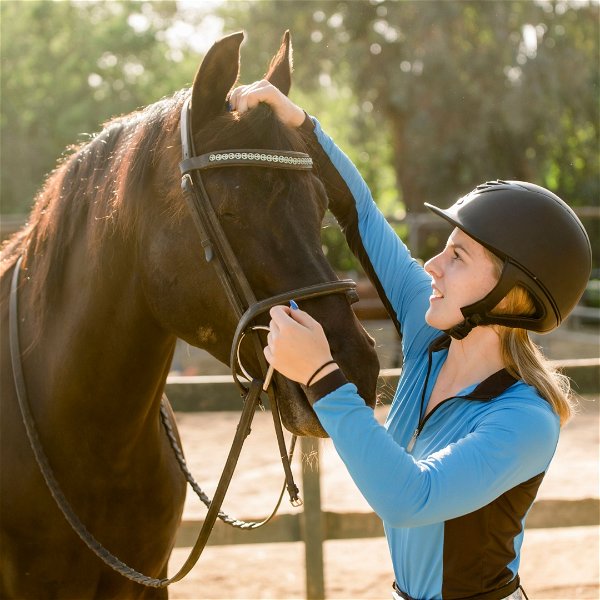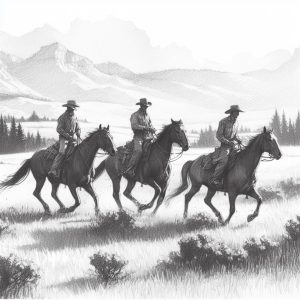In an alarming unfolding within the equestrian industry, the united community gathers force to stand against an escalating issue: horse abuse. “Revoked License Spurs United Action: The Equestrian Community Battles Horse Abuse” entails a profound insight into the cynical events casting a shadow over the vibrant world of horse racing. With a staggering estimate of around 50,000 racehorses subjected to mistreatment in 2020, the community and enthusiasts now band together, channeling their justified rage into a collective thrust to confront these grim realities. This unity was prompted by a video of a distressing incident involving a racehorse, circulating online, which invoked a sense of outrage and concern among the equestrian fraction, and eventually led to the revoking of the man responsible’s USTA license. The uprising has evoked demand for stringent steps to eradicate these prevalent issues, shedding a light on the pressing need to impart solid measures that assure the well-being of these majestic creatures involved in the sport.
The Dismal State of Horse Welfare in the Equestrian Community
Just as any other sport has its thrill and passion, so does the equestrian industry. It offers a stage whirling with adrenaline, an arena for enthusiasts to connect, and a course for animals to exhibit their majesty. Yet, it is through this very reliance on animals that the industry finds itself at the brink of a mounting controversy. The seemingly alluring on-ground entertainment often belies a distressful behind-the-scenes situation that has grown increasingly alarming in recent times.
Increasing cases of abuse and negligence
A dark reality, however, lurks within the industry. Cases of abuse and neglect against horses are tragically high. You’re perhaps already familiar with the grim scenes played out on the racetrack, but off the track too, horses continue to face deplorable conditions.
The stunning estimate by American Horse Council
According to the American Horse Council, an unpalatable fact has emerged concerning the wellbeing of racehorses. The council has estimated that in 2020 alone, approximately 50,000 racehorses were mistreated.
The rising concerns of the enthusiasts
Needless to say, such staggering numbers are a cause for great concern among equestrian enthusiasts. A sense of outrage has taken hold of the community, with growing voices demanding immediate action to address these distressing trends.
Evidence of Mistreatment: A Cry for Action
In an era where digital media rules supreme, the documented evidence of abuse against horses is becoming increasingly visible.
The disturbing contents of the viral video
Recently, a disturbing video went viral. The video, shared by a user on a popular social media platform, graphically showcased a racehorse being brutally mistreated at a stable, allegedly by someone of authority within the equestrian industry. The post, expectedly, unleashed a wave of public outcry, highlighting the grim realties hidden within the industry.
The backlash it provoked in the community
The fallout from the video was swift and severe, sparking widespread indignation and furor within the equestrian community. Enthusiasts gathered online, expressing their shock and complete condemnation of the act captured on film. There was an outpouring of calls for investigations and a demand for those-with-power within the community to take immediate action.
The role of social media in highlighting abuse
The video’s viral nature underscored the significant role social media plays in the fight against animal abuse. Platforms such as Twitter and Facebook have become vital tools for raising awareness and generating public outrage against acts of cruelty and neglect.

The Collective Outrage from the Equestrian Community
A stark reminder of the power of collective voices, the outrage emanating from enthusiasts across the globe led to a cry for justice.
The concern of the enthusiasts: calling for investigation
Concerned viewers demanded a thorough investigation into the incident. Amidst the wave of comments on the video, one asked pointedly, “Where is HISA to help with this investigation?” – stressing the need for intervention from regulatory bodies.
Recognizing the importance of action and strict measures
There was an echoing emphasis on the necessity of strict action against the guilty parties. One user wrote, “No animal should be treated this way. This is barbaric cruelty. This is totally unacceptable and something needs to be done.” The sentiment was echoed by others who expressed similar outrage and shock.
Feedback and recommendations by the community to address the issue
The community also proposed suggestions to curb such instances. These ranged from the strict implementation of rules to the publication of regular reports on the welfare of the horses employed in the industry.
The Immediate Response by the Authorities
As the online uproar grew louder, authorities responded by launching an investigation.
Identification of the abuser
The prompt action by the authorities led to the identification of the individual featured in the viral video. The suspected abuser was swiftly brought to task, demonstrating the determination the authorities do possess.
Revocation of the USTA license
In a decisive and firm action, the United States Trotting Association (USTA) stripped the offender of his license. The move was praised by many, including those who had drawn attention to the issue initially.
The demand for more stringent action by the enthusiasts
Despite the swift action by the USTA, there was a demand for an even stronger response. Enthusiasts called for the arrest and stringent punishment of the offender to send a clear message – that animal abuse and neglect will not be tolerated.

The Role of Regulatory Bodies in Horse Welfare
It’s undeniable that regulatory bodies play a crucial part in the safety and wellbeing of horses in the racing industry.
Appropriate reporting and investigation procedures
Regulatory bodies are tasked with investigating reports of abuse and ensuring that offenders are duly penalized. They can be instrumental in raising the standards of care for horses in the industry by implementing and enforcing procedures to prevent abuse.
How the Horse Racing Integrity and Safety Authority (HISA) is addressing the issue
The Horse Racing Integrity and Safety Authority (HISA) is one such regulatory body that has recently found itself in the spotlight. After the disturbing video went viral, the community questioned the role of HISA in facilitating the investigation and taking appropriate action.
The push for regulatory reforms in the industry
The incident sparked a broader debate about the need for significant regulatory reforms within the industry. Many believe that the regulatory bodies such as HISA should be laden with greater powers to ensure better welfare for the horses.
Preventative Measures to Combat Horse Abuse
There’s a pressing need for prevention measures that go beyond reaction and response to incidents of abuse.
The importance of stricter regulations
With the racing industry under scrutiny, the significance of stringent regulations cannot be overstated. These regulations can offer a robust framework for equine welfare, making it harder for such acts of cruelty to go unnoticed or unpunished.
The implementation of a zero-tolerance policy
A steadfast zero-tolerance policy towards cruelty and neglect should be ingrained in the ethos of the industry. Such a policy, supported by rigorous enforcement mechanisms, can deter potential offenders and protect horses from such unspeakable treatment.
Improving animal management practices in stables
Good management practices within stables are an integral part of ensuring horse welfare. It’s critical for those involved in horse care to receive continuous training on proper handling and care of these magnificent animals.
The Broader Impact of Horse Abuse
Beyond the unimaginable suffering inflicted on the horses, such instances of cruelty have wider implications for the entire racing industry.
The decline in racehorse owners and customers
Instances of horse abuse are leading to a palpable disillusionment among racehorse owners and customers. The viral video depicting the brutal treatment of a horse was captioned with a damning indictment: “If you ever want to know why racing is losing customers & owners…”.
Negative impact on the reputation of the equestrian community
In the age of the internet, nothing stays hidden. Incidents of animal cruelty tarnish the glitz and glamour associated with the sport, causing irreparable damage to the reputation of the equestrian community.
The significance of addressing these issues for the future of the sport
Such disregard for equine welfare risks making the sport a pariah in the public eye. To ensure a bright future for the sport, it’s therefore vital to look into these issues sincerely and work on eradicating them completely.
Unifying the Equestrian Community for Positive Change
To see positive change, the equestrian community must unite against horse abuse.
The role of collective action in combating abuse
The viral video incident is a powerful example of how collective outrage can spur action and instigate change. Collective action remains one of the most effective ways to combat horse abuse in the industry.
Community-driven initiatives to reform horse racing welfare
The community plays a pivotal role in promoting horse welfare. By engaging in orchestrated initiatives aimed at reform, the collective strength of the community can spearhead positive changes in the industry.
Using public outrage as a catalyst for change
Emotions run high when animal abuse is exposed. This public outrage can be harnessed as a powerful force to drive significant reforms in the industry and curb such heinous behaviors.
The Media’s Role in Highlighting Horse Abuse
The power of the media in bringing about change should not be underestimated.
Use of social media as a tool for raising awareness
Social media can serve as an influential tool in the fight against horse abuse. It enables activists and sympathizers to craft compelling narratives that touch people’s hearts and prompt them to take action.
The impact of viral content on public opinion
Viral content can dramatically influence public opinion—like the video that sparked outrage among many internet users. It was a startling depiction of the grim side of the equestrian world, serving as a call to action for everyone who saw it.
The importance of ethical reporting
Reporting on horse abuse ethically and responsibly can drive the momentum needed for viable solutions. Ethical reporting acts as a vehicle for awareness, spreading the harsh reality to those who may be oblivious to the issues faced by our equine companions.
More Than Just a Sport: Respecting the Dignity of Racehorses
Equestrian racing isn’t just about the grandeur, speed, and bets—it’s about the animals that make it possible. The sport exists because of them, and they deserve to be celebrated, not mistreated.
Understanding the intrinsic value of horses
Horses aren’t just objects of entertainment or avenues to profit. They are sentient beings, deserving respect and care. Inside and outside of the racetrack, they must be afforded the basic dignities inherent to all living creatures.
Moving beyond financial implications: the moral and ethical imperative to treat horses humanely
While the financial ramifications of horse abuse are unpleasant, they pale in comparison to the moral and ethical obligations we bear towards these creatures. Treating horses humanely isn’t just a matter of financial survival for the industry—it’s a moral imperative for us as a compassionate society.
Reaffirming the importance of respect and care in the equestrian community
The importance of respect and care for horses within the equestrian community cannot be overstated. This commitment to humane treatment must be continuously reaffirmed and upheld, serving as the cornerstone of the industry. After all, without the horses, there would be no sport.
